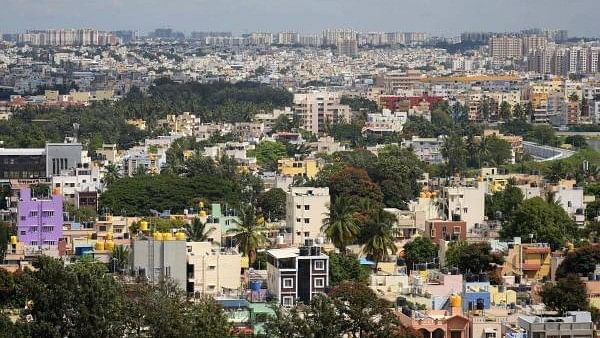
A view of Bengaluru city on Sunday.
Credit: DH File Photo/ Pushkar V
Bengaluru: Driven by strong consumer demand, the inventory overhang for the Indian residential real estate market dropped to 22 months in the second quarter (Q2) of the current calendar year (CY), down from 34 months in the corresponding period last year, according to a report by Proptiger.com released on Monday.
Inventory overhang is an estimated time required to sell off unsold stock at the prevailing monthly sales velocity.
During the period under consideration, unsold inventory saw a decline of 2 per cent year-on-year (YoY) to 9.26 lakh units. While Delhi-NCR registered the highest inventory overhang at 31 months from a high of 72 months, Kolkata logged the lowest at 16 months.
"This reduction underscores the market’s capacity to adapt to evolving conditions, maintaining overall stability and indicating sustained buyer interest across various regions," said Vikas Wadhawan, group CFO -REA India & Business Head, PropTiger.com.
"As we approach the festive season, we anticipate this positive momentum will continue to gain strength, further boosting market activity and buyer engagement across the country," he added
Ahmedabad and Bangalore saw significant reductions, dropping to 18 months from 33 months and 36 months, respectively. The Mumbai Metropolitan Region (MMR) and Pune accounted for 54 per cent of the total unsold inventory across the top eight cities at the end of the June quarter due to an increase in the number of new launches by developers in response to strong consumer demand.
Although the MMR's unsold housing stock rose 1 per cent to 3,39,362 units in April-June 2024 from 3,35,476 units in the corresponding period of the previous year, its inventory overhang declined to 26 months from 33 months during the same period.
Hyderabad and Chennai too, following the same trajectory, saw their inventory overhang decline to 26 months and 24 months, respectively, from 39 months and 28 months.
According to the report, Ahmedabad led the cities in reducing the unsold inventory by cutting over 12,500 units, followed by the NCR region, which saw a decrease of over 9,400 units in the period under review.